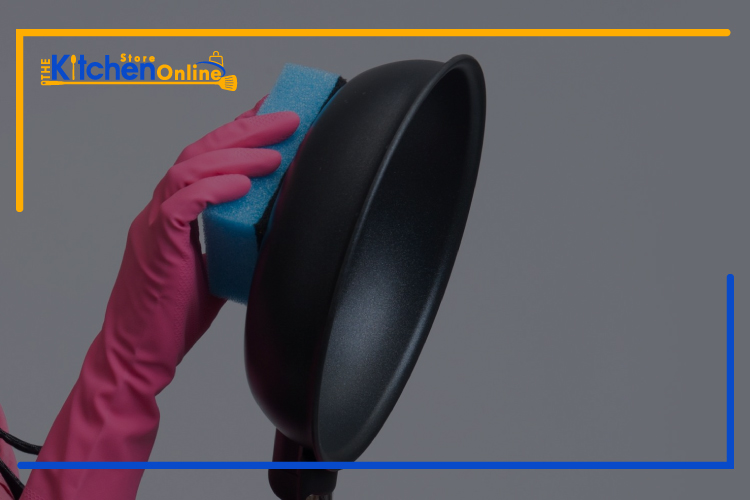Hard anodized cookware has brought about a revolution in the kitchen industry due to its heavy-duty durability and functionality.
A prominent reason why hard anodized cookware is so popular is that they are relatively easy to maintain. The hard anodized covering acts as a pretty great non-stick surface, and it has rust-resistant properties, so there are no problems there.
However, they need proper cleaning and care from time to time. Just because they are all toughened up does not mean that they’ll stay that way forever. So, that begs the question – how to clean hard anodized cookware exterior?
We have the perfect guide for you in today’s article. Here we will be discussing the various methods you can use to clean your hard-anodized cookware exteriors. You can read to know how to care for your precious cookware and also find out what you have been doing wrong all this time.
Do Hard Anodized Cookware Exterior Require Special Care?
Not necessarily. If we are speaking in a general sense, they don’t require as much attention as ceramic or marble cookware. Again, regular steel cookware may not require any special treatment, but they are hard to clean once grease builds up.
The same goes for rust development as well since regular steel cookware doesn’t have any protection against those types of nuisance.
So, considering those limitations, hard anodized cookware is the best deal out of the bunch. They provide a smooth, almost non-stick cooking surface, and that’s why it’s not only easier to cook but also easier to clean. Grease cannot build up as easily, and even if they do, it doesn’t take much to get them out.
Furthermore, hard anodized cookware is usually made of high-quality materials like aluminum and stainless steel. These premium-grade materials have a unique property that prevents excessive burn-offs and rust.
Sometimes, they are also protected against water damage, and that’s why they have long-lasting functionality and durability.
However, as we mentioned earlier, just because hard anodized cookware has a lot of positive features does not mean that they are entirely immune to damage. Grease still builds up, and food does get burnt a lot of the time.
Therefore, it’s just as necessary to take proper care and do due cleaning of this cookware to prevent such mishaps from taking place.
How to Clean Hard Anodized Cookware Exterior?
There are several ways to clean a hard anodized cookware exterior. Now, keep in mind that the cookware exterior goes through a lot of heavy damage than the inside of the cookware. They are often exposed to high temperature for a long time and thus, needs way better treatment than the inside surface.
Hard anodized cookware exteriors are indeed built to last damages against high temperatures. But the damage can escalate quite easily if it’s not cleaned regularly.
Again, sometimes the foods like soup or curry overflow, and those food residues get stuck to the exterior causing further damage over time. Here are a few ways how you can clean the bodies of your hard anodized cookware:
- Use a Baking Soda Solution
Baking soda is a timeless solution for most of the cleaning around the kitchen. If nothing seems to work for any type of cleaning, baking soda is always there to save the day. They have special oxidizing power that can easily act as a cleaning solution whenever needed.
To clean the exteriors of your hard anodized cookware via this process, you will need to prepare the baking soda solution first. It’s literally as easy as it gets.
Take a bowl of water filled to the three-quarter mark, and add three-four tablespoons of baking soda to it. You can add a little more if you feel like you need the extra strength.
Wear gloves while handling this baking soda solution as they can be quite corrosive on the human skin. This is also the reason why our hands seem to lose moisture after a dishwashing session, in case you were wondering.
Anyways, once the solution is prepared, transfer it to a bigger bowl and soak your hard anodized cookware for at least an hour. Reminder, the water needs to be warm or at least lukewarm for the concoction to work more effectively. Do not use boiling hot water, though.
If you are looking to wash a bunch of this hard anodized cookware at once, prepare a much larger batch of this solution. Fill up the sink with this baking soda-warm water mixture, and then dump all your dirty hard anodized cookware in there.
Keep them in there for as long as you can so that the cleaning solution can work against the dirt on the cookware surface and loosen them up.
After a proper amount of time has elapsed and the solution has had enough time to soak and loosen out all the dirt, it’s time for scrubbing. The scrubbing will help to get the softened-up greases and burnt flakes from the surface in just a few swipes. Use nylon scrubs or any other scrubs available in your kitchen to do the scrubbing.
As long as it gets the job done, it shouldn’t matter what type or brand of scrubs you are using. However, if the cookware brand specifies a certain scrub for scrubbing purposes, it’s best to use that one while cleaning.
For example – the Calphalon Hard Anodized Cookware comes with specific instructions to use the scotch Brite pad for their cookware.
One other thing that you should keep in mind is that several hard anodized cookware is not protected against scratch marks or stains. So, unless the instructions say otherwise, be very gentle with the scrubbing session so that the exterior does not get any scratches on it.
After you are done with the scrubbing, wash it off under tap water like any normal utensil and dry it off. And that is all it takes to clean the hard anodized cookware exterior.
- Use a Dish-washing Liquid Solution
This is an alternative to the first procedure. Usually, most cookware brands will come with proper instructions on how and what dishwashing liquid to use for their products. If your one does as well, follow the instructions to the T to properly clean your hard anodized cookware.
Dish-washing liquids are generally used for day-to-day cleaning and not deep cleaning sessions. That’s why you don’t have to make a separate mixture and soak the cookware for hours.
Just use some warm water to wet the scrub or sponge, pour some soapy liquid on it and scrub away. Once it’s clean after proper scrubbing, use tap water to wash everything.
The washing part is actually more crucial than people may think. The main reason why your food has a mechanical or soapy taste is that the cookware wasn’t washed properly. So, take your time and wash every nook to get all the soapy substances out before drying and storing the cookware away.
- Use a Scouring Powder
There’s not any real difference at all between dish-washing liquids and scouring powder except their physical state. If you are more comfortable with powdered substances, make a concoction following the baking soda one. The rest of the procedure is also pretty similar.
If the cookware exterior needs a deep cleaning, soak it in the warm mixture for half an hour or more and then scrub it off. If not, you can use a soft bristle brush to clean it the regular way. Use enough water to wash away the powder completely.
Always remember to properly dry off the hard anodized cookware with a soft cloth or towel after washing. Residual water can create water stains on the cookware surface if they are not dried up properly.
What Not to Do While Cleaning Hard Anodized Cookware Exterior?
Now that you know how to clean hard anodized cookware exterior, it’s time to find out what not to do while cleaning one. If you manage to remember these, you can increase the longevity and durability of your cookware tenfold.
- Do Not Use a Dishwasher for Your Hard Anodized Cookware!
Several, and by several, most hard anodized cookware is not dishwasher safe at all. These types of cookware require personal care and cleaning. Using a dishwasher will cause multiple scratches that can reduce the functionality of your precious cookware.
But that doesn’t mean that there aren’t dishwasher-friendly cookwares out in the market. However, read the instructions properly before using any of the cookware in the dishwasher. Unless the instructions explicitly say that it is dishwasher safe, don’t even think of putting hard anodized cookware in there.
- Do Not Use Hot Water While Washing a Hard Anodized Cookware
Generally, boiling hot water should not be used for any type of cookware washing as it can corrode the exterior. The high temperature comes as a shock to the soft soapy concoction and gets way too activated than necessary.
Plus, since hard anodized cookware has an aluminum or steel exterior, the hot water can permanently cause the surface to warp.
So, unless you want a battered and warped surface, cool down your hard anodized cookware before dumping it in the sink. Also, use lukewarm water for washing and scrubbing purposes, not boiling.
Conclusion
So, have you gotten the answer on how to clean hard anodized cookware exterior? We certainly hope so! If you were paying attention, this article should be of great help to you for taking care of precious cookware. Have a great day, and thanks for reading until the end!





